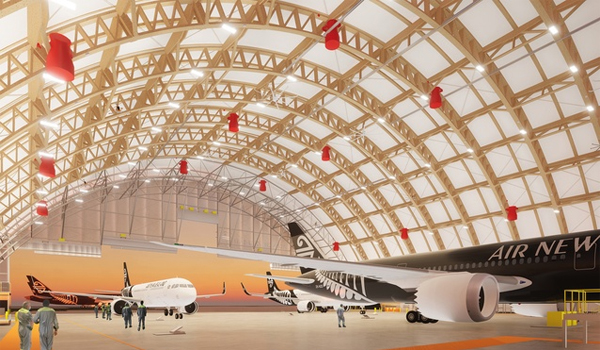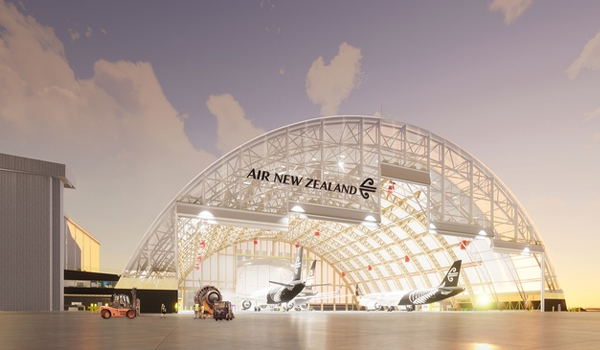Saturday, December 2, 2023
|
Listen to this news
|

Hangar 4 in Auckland – the unique aircraft hangar, which will be completed in early 2025, designed and executed by Studio Pacific Architecture sets record for size. It will be the flagship hangar for Air New Zealand. Hangar 4 will be the largest single-span timber arch aircraft hangar in the southern hemisphere. At one and a half times the size of the airline’s largest existing hangar, it will be able to house one wide-bodied aircraft, such as a Boeing 777-300 or 787-9, as well as two narrow-bodied aircraft, such as an A320 or an A321neo, at the same time.
This unique laminated veneer lumber (LVL) and cross-laminated timber (CLT) are signified as hybrid timber arch. These are designed in association with structural engineer Alistair Cattanach of Dunning Thornton, spans 98 metres and has a low total structure mass, making it considerably easier and more efficient to put together on site than a similarly sized steel structure would be.
“In 2018, Air New Zealand committed to applying its Sustainable Building Guidelines across its property and infrastructure initiatives,” explains Thompson, “so Hangar 4 has been designed to be a 5–6 Green Star rated building, certified by the New Zealand Green Building Council.” Thompson added further.

Lead architect Patrick Thompson says the arch geometry also resulted in an increased net-useable floor area in the hangar, which will provide for internal storage of equipment and aircraft planning offices. Specialist services to the planes will be delivered underground to service pits. The ETFE-pillow building envelope will provide insulation to the hangar and controlled daylight, and the main opening will be a fabric lifting door.
The hangar represents a significant advancement in building innovation when compared with previous use of timber, such as the glulam in Auckland’s Hangar 1. “With the use of modern engineered timber available today, the hangar has the ability to become a worldleading example of innovation and creativity,” says Kulwinder Panesar, Senior Project Manager at Air New Zealand. “As timber is a net carbon sink, building a timber hangar structure instead of a steel structure results in savings of close to 600 tonnes of CO² equivalent, which equates to approximately 2300 hours of flight time.” Panesar concluded.
The most interesting part of this entire project is, the timber is also naturally inert to corrosion in what is a salt-laden atmospheric environment, where a steel structure would have required protection treatment and ongoing maintenance.
Read more news on: Timber projects
Source and image courtesy: Architecturenow
Tags: architecture, CLT, LVL, timber projects, woodworking, woodworking and processing
Comments: